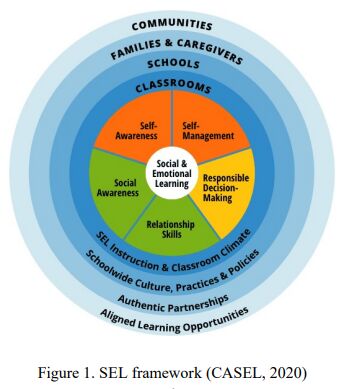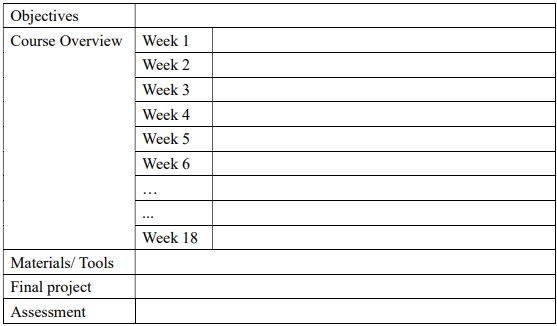載入中..請稍候..
【詳解卡福利】寫作批改懸賞券,將於 2025/04/30 23:59:59 過期,還沒使用或領取,趕快前往領取並使用吧! 前往查看
(B) In recent years, the importance of Social and Emotional Learning (SEL) has been widely recognized in education. As an English teacher in a senior high school, you may encounter students struggling with interpersonal conflicts, emotional regulation, or family-related issues.
Please write an essay discussing how SEL principles can be integrated into English language teaching to help students cope with such challenges. You should:
● Share your experience with helping students deal with interpersonal conflicts such as peer conflict, emotional stress, or family problems.
● Provide at least two specific teaching strategies or classroom activities that promote SEL in the context of English learning.
● Illustrate how these strategies can help students deal with such issues. Y
our response should be around 250–300 words. Use clear organization, appropriate examples. The following figure provide you with the SEL framework from CASEL (2020).
IV. Essay writing (A)Yang Ming Senior High School has a sister-school relationship with a high school in Japan. Every year, Japanese students visit Yang Ming and participate in cultural exchange activities with our students. As both the English and homeroom teacher, design an activity that allows your students to interact meaningfully with students from other countries. Please write an essay describing your proposed cultural exchange activity. Your essay should include:
● A clear explanation of the objectives of the activity (e.g., language practice, cultural comparison, global citizenship).
● A detailed description of the roles of the teacher and students in the activity.
● Specify procedures or steps of the activity and how students will engage with international peers.
● A brief reflection on how this activity supports both English learning and intercultural competence.
III. Course Design
One of the aims of international education is to cultivate global citizenship, which includes understanding a country's place and characteristics in the world, thereby helping build self-esteem and confidence in one’s nation and culture. In addition, this goal also emphasizes strengthening international mobility through the development of foreign language skills, critical thinking and 3 inquiry abilities, the ability to gather and apply technological information, and cross-cultural communication.
Please make use of the first article as an inspiration to design a 18-week project-based English course that fosters students' global citizenship, with a focus on speaking and listening skills. The goal of the course is to help students improve their English language skills while deepening their understanding of Taiwanese cultural practices (e.g., placing “Kuai Kuai” snacks on machines, traditional rituals such as “soul-calling” or setting off firecrackers, seasonal health foods, etc.). Students will generate their own topic related to Taiwanese cultural practices and present them in English.
(2) Write a 250-word explanation of how you will use AI/technology tools to support learning and briefly share your past experiences of using them in your course.
請閱讀下面文章,回答第 49~50 題
Ū tsit tīn niáu-tshí, khuànn in ê tâng-phuānn sî-siông hōo niau-á kā--khì; tō tsò-hué tsham-siông beh án-tsuánn lâi tuì-hù niau-á. Ū tsi̍t tsiah siáu-liân--ê thê-gī kóng: “Iōng hâm-lîng-á pa̍ k tī niau-á ê ām-kún, i nā lâi tō ē long-long-kiò; lán tō ē tsai, thang kuánn-kín tsáu-khì bih tī khang--lí.”
Ta̍ k-ke thiann-liáu lóng tsin huann-hí, koh o-ló hit tsiah siáu-liân niáu-tshí tsiânn khiáu, kóng: “Í-tsîng--ê si̍t-tsāi tsin gōng, thài ē bē-hiáu án-ne tsò.”
Hit-sî, guân-pún tī pinn-á bô tshut-siann ê lāu niáu-tshí-thâu, khui-tshuì kóng: “Nā án-ne, tó tsi̍t tsiah beh khì kā niau-á kuà hâm-lîng-á?” Suah bô puànn tsiah niáu-tshí kánn ìn.
50. Tshiánn-mn̄g ē-bīn tó tsi̍t ê siōng sik-ha̍ p tsò tsit phinn kòo-sū ê piau-tê? (A) Jîn-tsîng lâu tsi̍t suànn, ji̍t-āu hó sio-khuànn (B) Kóng khah khuài, tsò khah oh (C) Ji̍p hóo kháu, bô sí iā oo-áu (D) Lâng buē kàu, siann sing kàu
49. Tshiánn-mn̄g siáu-liân niáu-tshí ê thé-gī ū siánn-mih kiat-kó? (A) Hōo lâng phí-siùnn (B) Tit-tio̍ h it-tì ê tsàn-sîng (C) Thong-lâng kiann-hiânn (D) Uân-tsuân bô kong-hāu
請閱讀下面文章,回答第 46~48 題
A-má ū tsi̍t hāng siōng sim-sik--ê tō sī ài-khùn. 46 tsia̍ h-pá, ài-khùn-sîn tō lâi. Tī khǹg lo̍ h toh-tíng, ba̍ k-tsiu 47 tō khùn--khì. Tsē tuà í-á-tíng ná tuh-ku ná kônn, kì-tsāi lâng án-tsuánn kóng-uē, án-tsuánn tshá iā bô-iàu-kín. Guán bat iōng soh-á kā i ngiau hīnn-khang, mā-sī ngiau bē tshénn. It-tīng tio̍ h tuh puànn tiám-tsing, khùn-pá bián lâng kiò, ka-kī tō tsing-sîn--khí-lâi, hó-sè-liu-liu, ba̍ k-tsiu kim-tak-tak, 48 tú-tsiah bô khùn--khì án-ne.
-- Tân Luî〈Kui-jîn a-má〉
48. (A) huān-sè (B) bē-su (C) khióng-kiann (D) tiānn-tio̍ h
This is a large modal.